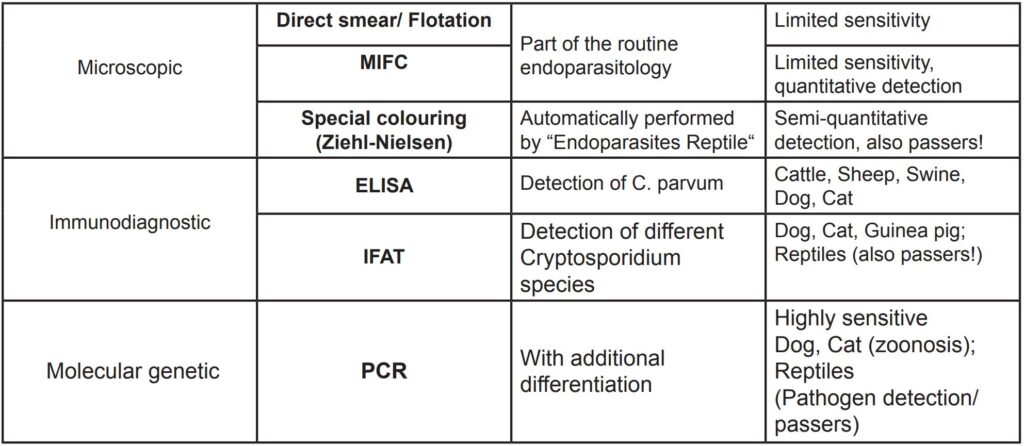Cryptosporidium are very small, obligate intracellular protozoans belonging to the Coccidia. One of the most common pathogens in humans and mammals is Cryptosporidium parvum. Within this species are again molecular genetic differentiated genotypes (human, cattle, mouse).
Cryptosporidiosis in cattle is one of the most common endoparasitism. Between 25% and 100% of calves get infected by C.parvum. Clinical cases are particularly seen in calves up to 3 weeks of age in connection with co-infections, primarily with Rota virus but also Corona virus and E. coli.
Not uncommonly, lambs, piglets or foals are also affected.
A far lower prevalence are seen in dogs and cats (München: dog 0%, cat 1,3%; Austria: dog 0,6%, cat 3,4%). Manifest infections occur in puppies. Besides C. parvum, both C. canis and C. felis can cause diarrhoea in dogs respectively cats with fever, weight loss and rectal prolapse, but these species are only in isolated cases found in humans. C. hominis, an important diarrhoeal pathogen in children is not pathogenic to animals. Cryptosporidiosis in humans is possible at any age.
Unapparent infections or mild clinical cases are seen in immune-competent humans. Diarrhoea with cholera-similar magnitude is seen in immune- depressed persons, particularly in HIV-patients.
Cryptosporidiosis in reptiles is a serious disease that can, especially in snakes and lizards cause severe losses.
C. serpentis is an important parasite in snakes and affects the gastric mucosa. Due to the induced chronic infection, a subsequent swelling and fibrous hardening in the gastric region occurs. Typically regurgitation of food is seen days after digestion. C. saurophilum destroys the mucous membrane of the intestinal wall of affected snakes and lizards. Clinically a malabsorption with excretion of undigested food, profound weight and fluid loss are seen. Both are not pathogenic to humans. Not often are C. muris and C. parvum found as intestinal passers in reptile faeces (infected prey animals).
Transmission occurs primarily through contaminated water or raw foods, but also by smear infections as infectious Cryptosporidium are excreted (direct zoonosis!).
The infectious dose is very low (approx. 100 oocysts). In average does an affected calf shed 90 oocytes/g faeces, which are widely distributed by subsequent fertilizing. In the USA large epidemics are regularly seen caused by contaminated drinking water (1993, Milwaukee approx. 400.000 affected people). In Europe similar outbreaks have so far not been seen. According to the technical university of Vienna, next to Giardia duodenalis and EHEC, Cryptosporidium are considered the most relevant water-associated pathogen. In Germany 36% of drinking water samples are tested positive for Cryptosporidium.
- Fig. 1. Crptoyporidium
- Fig. 2. Cryptosporidium
- Tab. 1: Cryptosporidium diagnostics
Disinfection procedures are very difficult, as chlorine alone is not enough. Only in combination with an ozonation Cryptosporidium contaminated drinking water can be sanitized. Contaminated stables and terrariums are common sources of infections, as the oocysts can remain infectious for months.
For laboratory diagnostics, several methods for detection are available. Already on a microscopic examination after specific enrichment (MIFC) oocysts can sometimes be found. Like all parasitological faeces examinations the sensitivity is limited to about 60%.
Reptile faeces samples are additionally coloured (modified Ziehl-Nielsen stain) before microscopy to increase the detection rate. In cattle, it is recommended to use the ELISA test for detection of C. parvum.
Immunofluorescence includes a wider range of Cryptosporidium species and is therefore more suitable for dogs, cats as well as small rodents (guinea pigs, C. wrairi).
In reptiles, a positive IFAT result cannot distinguish between pathogenic intestinal pathogens and passers.
Here the PCR test with connected differentiation can provide very sensitive and accurate pathogen detection.
A successful therapy is still not available. Symptomatic therapy and hygiene management are crucial in the fight against Cryptosporidiosis. For calves that still drinks milk and have an immature rumen, Halocur® is allowed in the EU. For dogs and cats there are no approved chemotherapeutic drugs.
Cryptosporidium diagnostics:
A reduction in the oocysts excretion in cats can be achieved with Paromomycin, Tylosin or Azithromycin, but there is no specific information on success rate. In reptiles Sulphonamides or Tolturazil are used experimentally.






